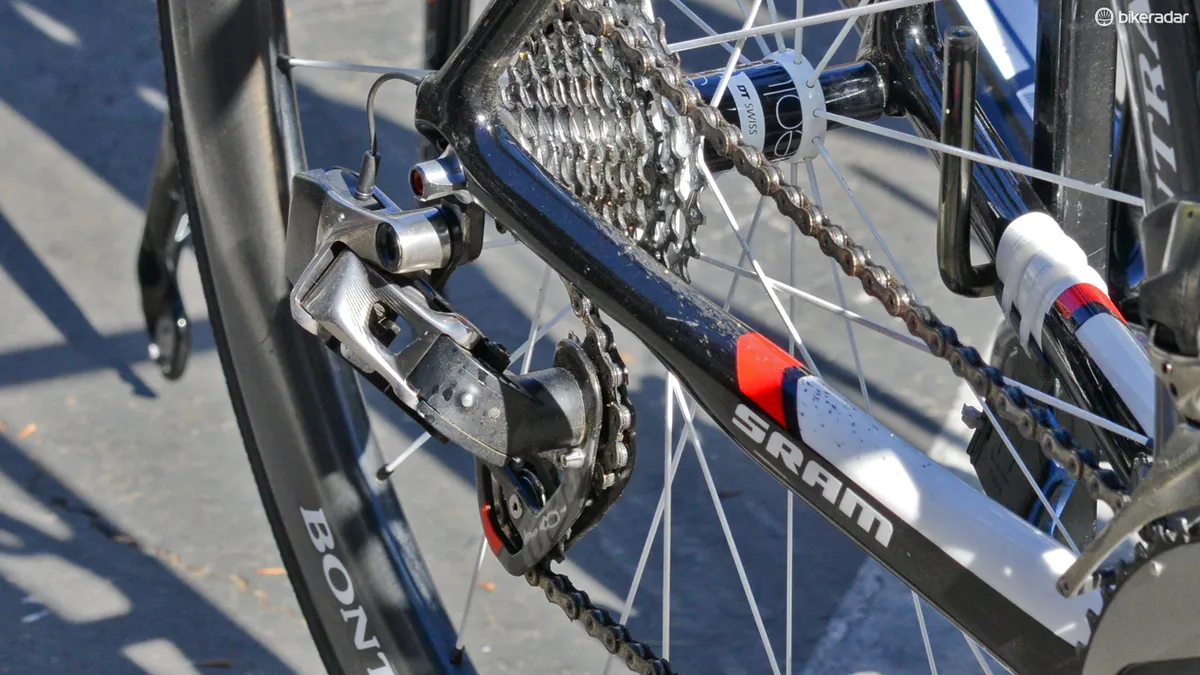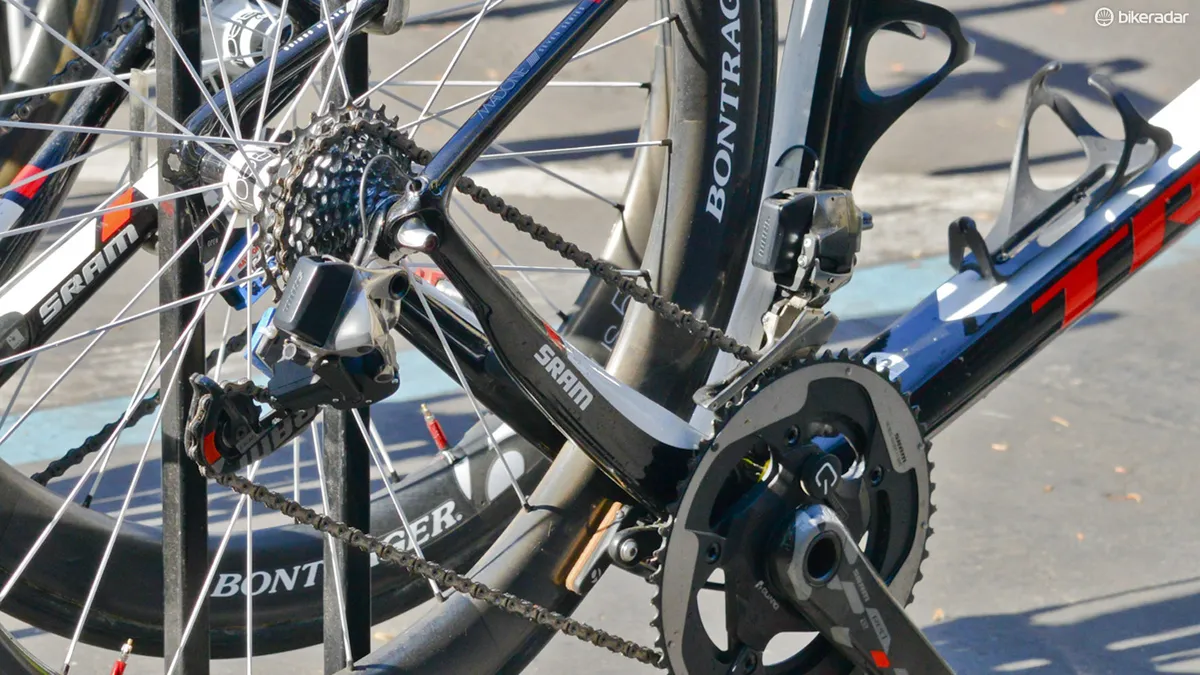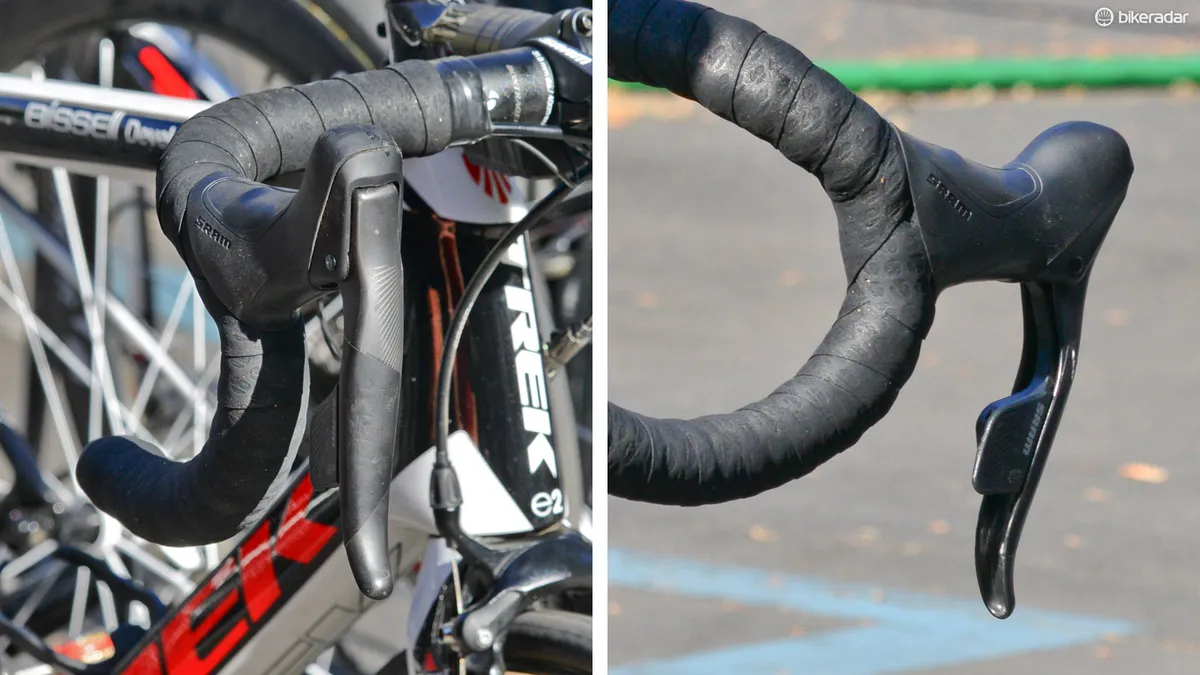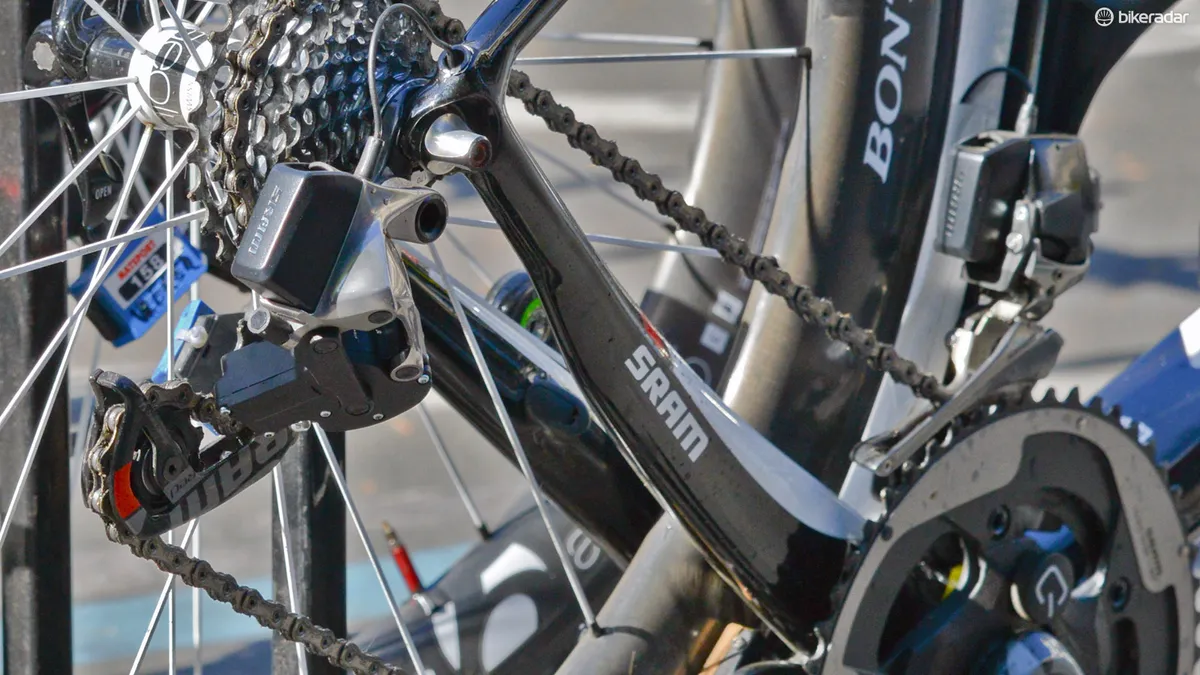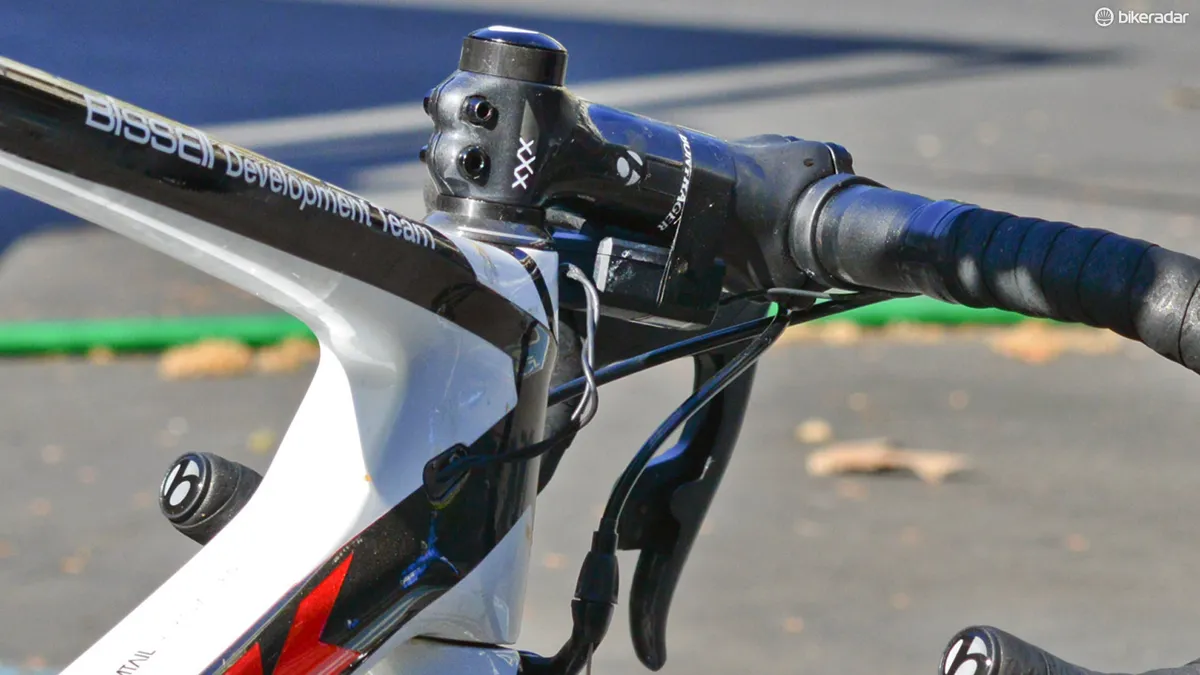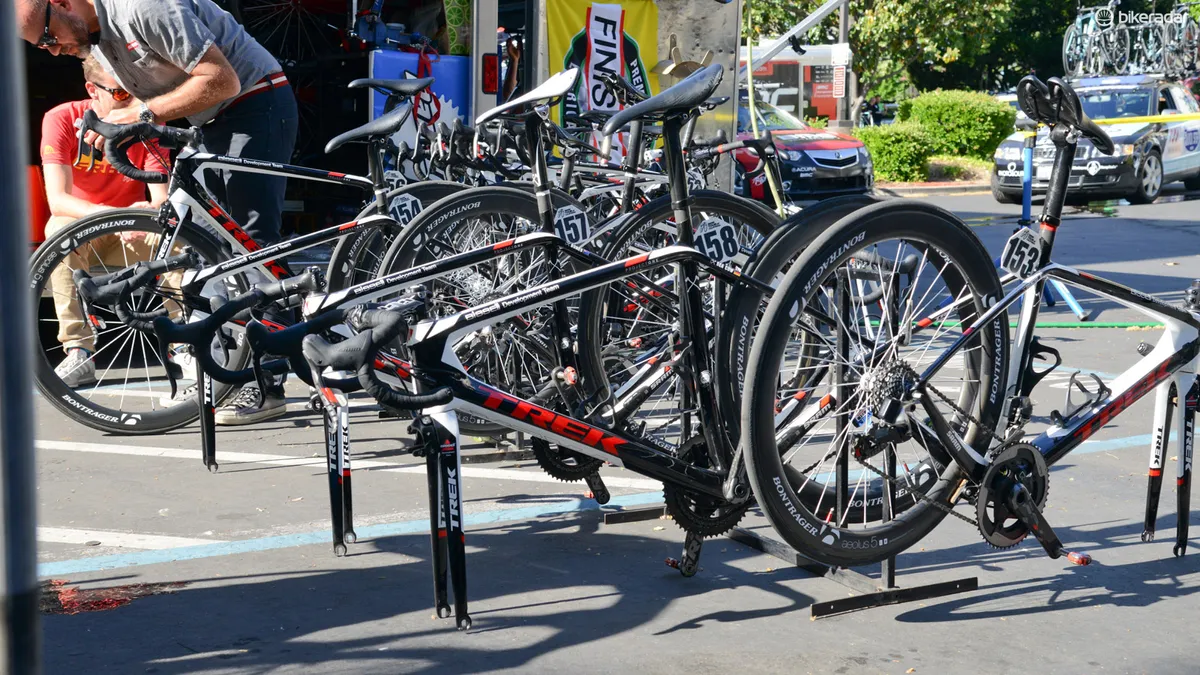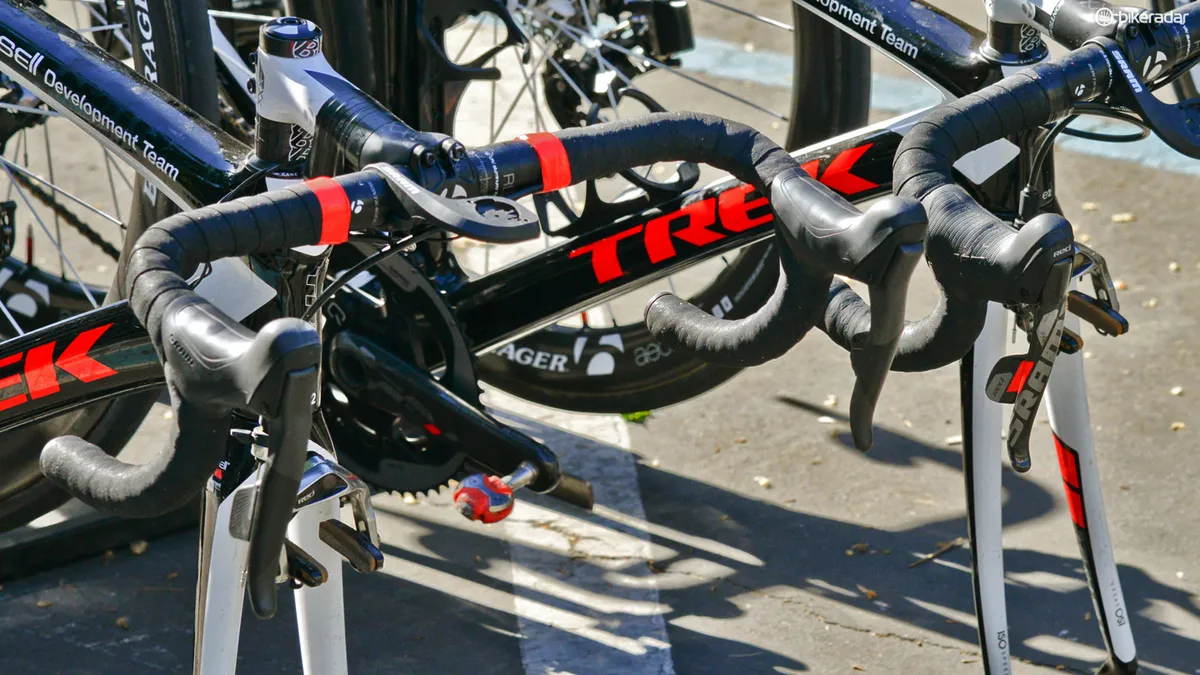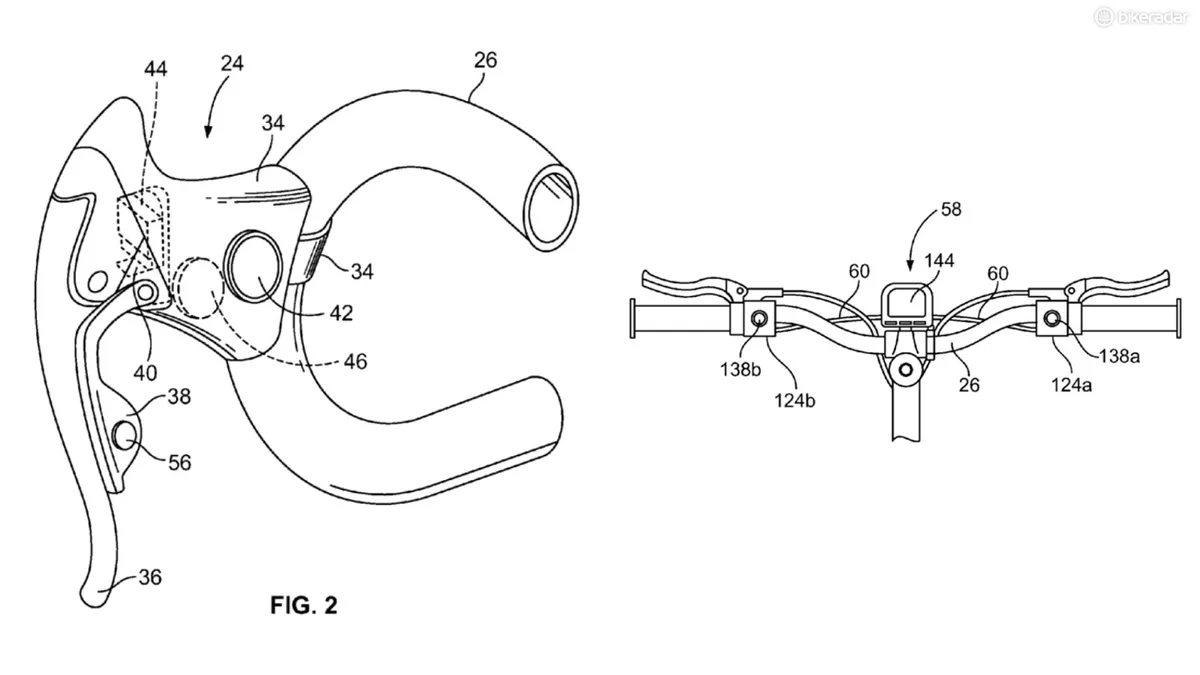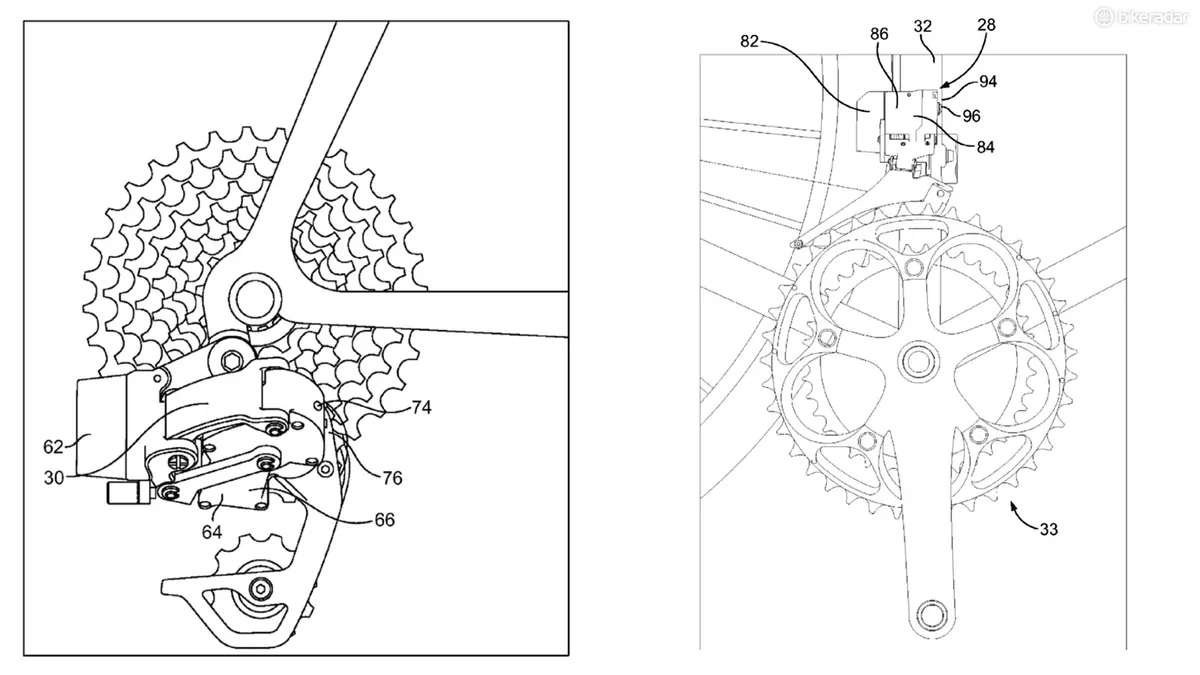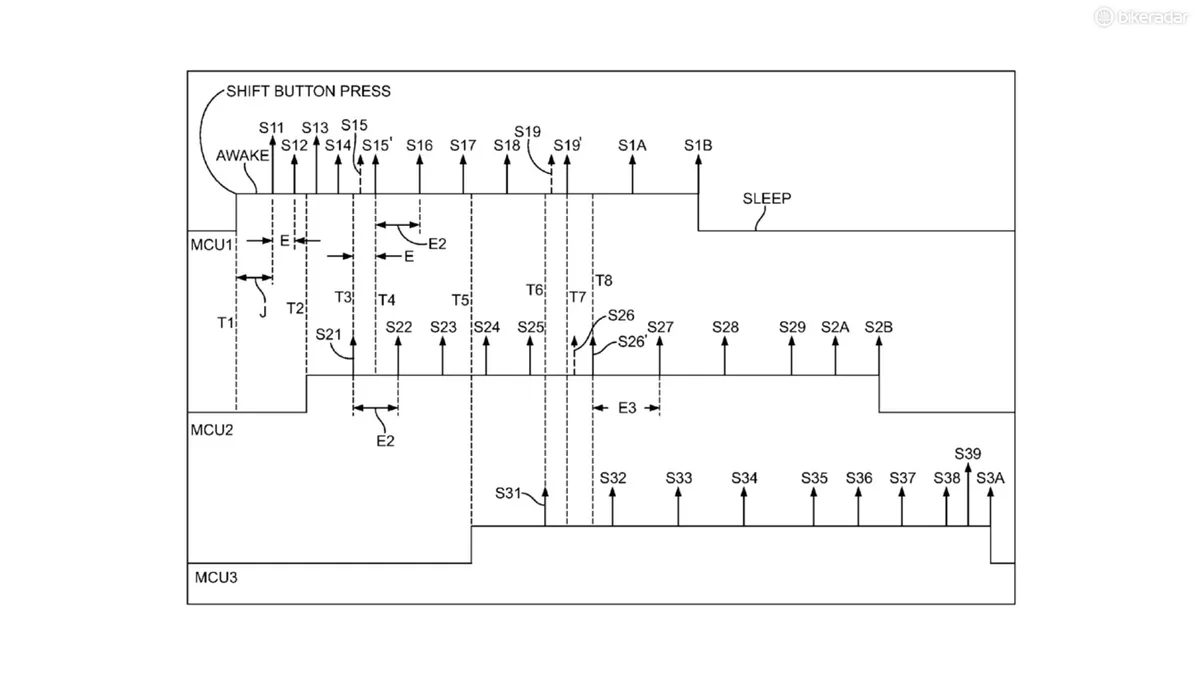SRAM is developing an electronic road drivetrain, and based on US Patent Office documents BikeRadar acquired and examinations of a prototype group at the Amgen Tour of California, we are confident that it will be a fully wireless system that could weigh less than the wired electronic drivetrains from Shimano and Campagnolo.
It appears the new group will also usher in a new type of shifting — a button on the left lever will move the rear derailleur one way and a button on the right lever will move it the other way; pressing both will shift the front derailleur.
Nearly six years after the launch of Shimano's first Dura-Ace Di2 group and two and a half years since Campagnolo followed suit, SRAM is well behind the curve. SRAM declined to comment on its developments, but here we present a case as to why we believe SRAM's electric group will be wireless.
A wireless electronic group - hidden in plain sight
A quick look at a prototype electric SRAM drivetrain show wires, but a closer look reveals something more. Wires conspicuously jut out of the top of both the front and rear derailleurs, and there are two other wires that exit the back of a box mounted beneath the stem. The assumption has been that those wires send signals back and forth from one to the other, but we're convinced that it's an elaborate ruse.
For starters, just compare the look of the wiring to the finish on the rest of the package. The connection points to the derailleurs are strangely located, oddly crude with no clearly discernible sockets, and the strain reliefs are awkwardly positioned. Those reliefs are even occasionally missing altogether, leaving nothing but a basic hole with visible tool marks in the surrounding plastic.
The stem-mounted box, meanwhile, yields clues that there's absolutely nothing inside.
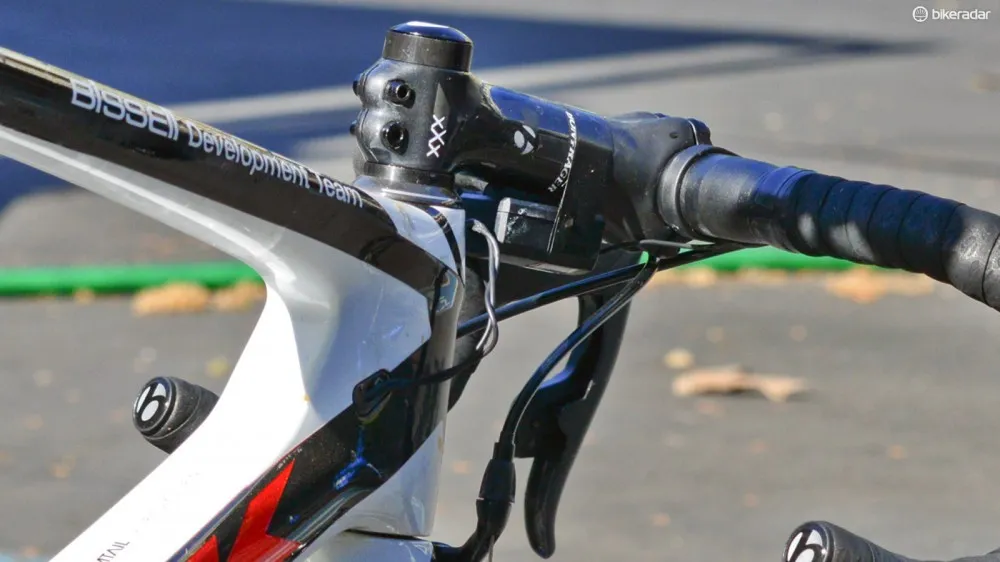
Don't be fooled. Those wires aren't real
Few things are certain in life but one virtual guarantee is that electronic hardware gets smaller with time, not bigger, and this thing is absolutely huge compared to similar units from Shimano and Campagnolo. Even if there's a battery inside as some (including us) have speculated, there's simply no reason for it to be that big. There are no physical parts to move that would need that kind of power and any requisite wireless signal transmissions wouldn't require anything that bulky.
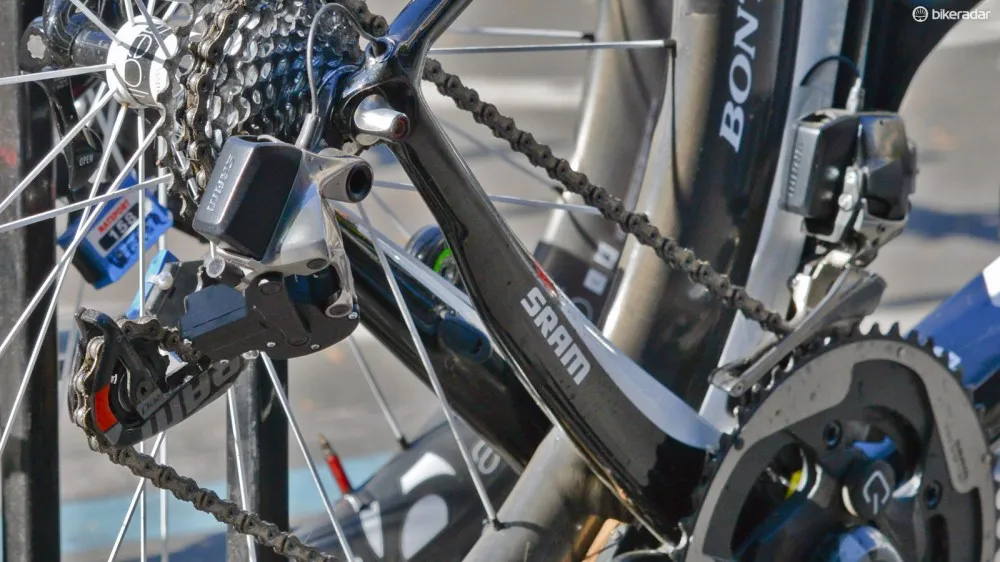
Those big boxes on the back of the derailleurs aren't motors, they're batteries. Note that they're identical with locking clasps clearly visible on top
Then there are the wires themselves. The ones supposedly leading to the derailleurs, for example, exit cleanly but they're clumsily twisted together while the ones feeding into the frame look to be held in place with wads of electrical tape. Moreover, the wiring insulation bears white lettering that not only doesn't read 'SRAM' but looks more like what's printed on wire one would buy from a local radio supply shop.
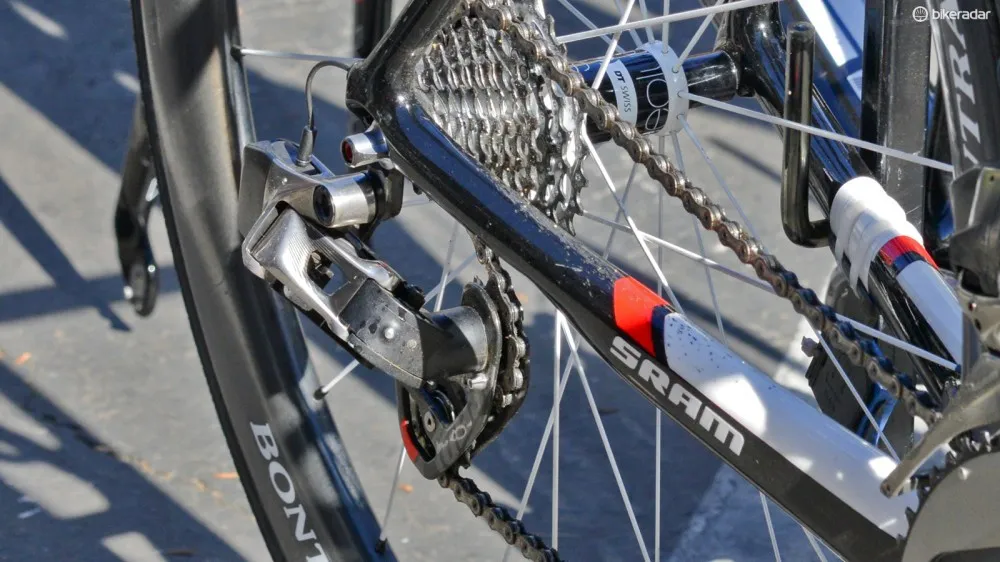
This wire isn't real, either
No self-respecting electrical engineer would use such basic twisted-pair wiring like this for what otherwise is a nearly finished prototype.
Perhaps most importantly, SRAM has a long history of strong industrial design, pre-planned 'leaks', and engineered 'spy shots', and this setup as is fits well with that well established MO. Put plainly, this box is ugly. While the rest of the group is impressively well finished, this 'junction box' is just some generic plastic bit with no clear method of attachment and, in fact, no bicycle specificity whatsoever.
Also, it makes no sense because there's no functional reason for it to be there. If you remove the DoubleTap mechanical shifting guts from the inside of the lever bodies, there's more than enough room inside for everything required.
Say goodbye to DoubleTap
Company patent documents filed with the United States Patent and Trademark Office just a couple of weeks ago reveal even more. If the documentation is to be taken at face value (as it should, given the nature of the documentation), SRAM's new electronic system will be fully wireless from tip to tail. There are no wires connecting the levers to the derailleurs and none connecting the levers to each other. In fact, there are no external wires whatsoever, which bodes well for weather sealing, if nothing else.

The patent documents reveal a lot of information. Most of it appears to apply to the group in question but some bits are merely reserved for future possible use
Each shift lever and derailleur will directly incorporate its own separate rechargeable battery (presumably with some sort of high-density Li-ion chemistry), transmitter, receiver and 'brain'. Moreover, each shift lever will be linked to each derailleur for a total of four wireless connections.
Although there's no specific mention in the documentation, the availability of optional satellite shifters such as for time trials and climbing seems highly likely – if only for the system to be competitive.
In addition to the new group marking SRAM's first move away from a purely mechanical system, this electronic group will also do away with the company's long-standing DoubleTap shift actuation whereby a short lever push moves the corresponding derailleur in one direction while a longer push moves it in the opposite direction. This is particularly noteworthy since Brian Jordan, the SRAM engineer who originally conceived of DoubleTap, is also the primary figure listed on this latest patent application.
Instead, tapping the left-hand shifter paddle will move the rear derailleur to an easier gear while tapping the right-hand one will move it to a harder gear. Front shifts are performed by pushing both paddles at once, although the wording specifically calls out a 1x-compatible setup as well that should play with the cyclocross crowd.
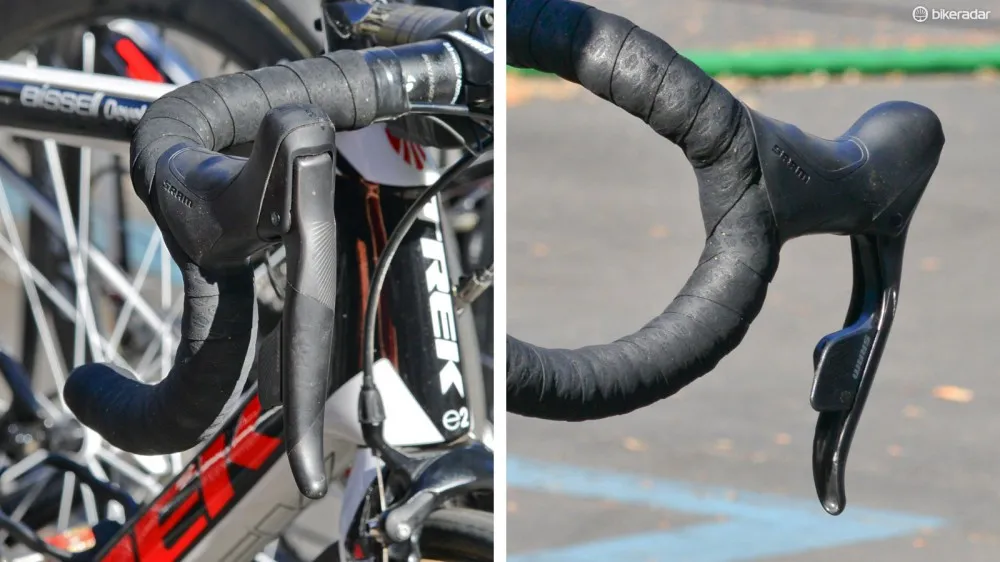
Say goodbye to DoubleTap as we know it. Push one paddle to upshift, the other to downshift. Push both to switch chainrings
Some aspects of the system remain unclear. One short tap will assuredly move the derailleur just one cog but at this point, we don't know if holding it down will allow for multiple steps a la Campagnolo and Dura-Ace. Likewise, there's no mention in the patent documentation of a fully sequential mode whereby the system will automatically move the front and rear derailleurs to provide the most logical combination.
Given SRAM's preference for rider-oriented control, though, we don't expect to see such a thing – at least not as a default setting – but the patent documents do suggest an automatic front trim feature.
We have yet to lay our hands on the system but a visual inspection reveals ultra-short lever throws. We expect those throws to continue on with SRAM's highly tactile, feedback-laden feel so at least that aspect would be familiar to current users interested in making the switch.
Impressive electrical engineering
Considering this will be SRAM's first foray into the electronic drivetrain scene, there's an impressive amount of electronic engineering work outlined in the paperwork, including a well thought-out mechanism to shield the system from outside interference – be it other riders, a competing team in a nearby vehicle, or anyone standing on the side of the road.
Pairing all of the bits together also sounds like a simple process that should be well familiar to anyone with a Bluetooth headset. Holding down a button on the derailleur will put that component into pairing mode, which is indicated by a flashing onboard LED. The derailleur will then scan for a corresponding shift paddle push, at which point the LED will go solid and the two bits are paired.
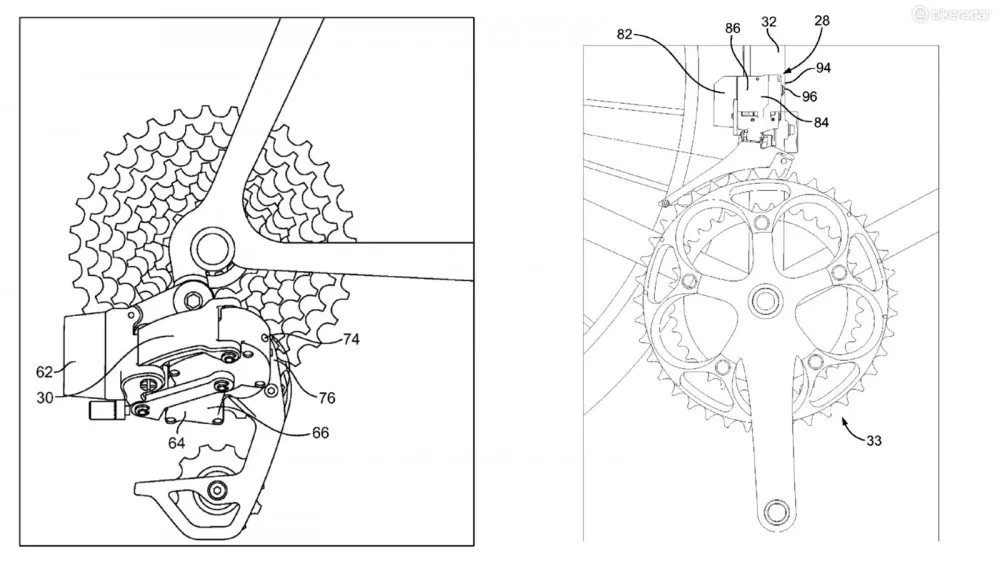
Outlined on the patent diagrams are specific locations for the batteries, 'brains', motors, buttons and indicator lights
Built-in memory chips will retain that pairing and each component will bear a unique digital device ID. At least in theory then, you'll only have to do the initial setup once and each 'smart' component will know the identity of everyone else.
More impressive is the actual method by which the system's signals are sent and received. Rather than send a continuous signal whenever a shift paddle is pushed – a conventional approach, but one that SRAM's patent documentation contend requires too much power – each transmitter instead uses a parsed transmission. In addition, the receivers' electronic ears aren't actually tuned to receive full-time, either, and in fact pay attention to incoming signals in a similarly parsed fashion.
In some way, you can think of it as Morse code. Signals are sent as a series of 'dashes' and 'dots' with predetermined tone lengths and pauses, and the receiving antennas are switched on in similar fashion. Staggering the pattern of those dashes and dots between the transmitters and receivers essentially ensures that the two overlap at some point, thus letting the signal get through from shifter to derailleur and vice versa.
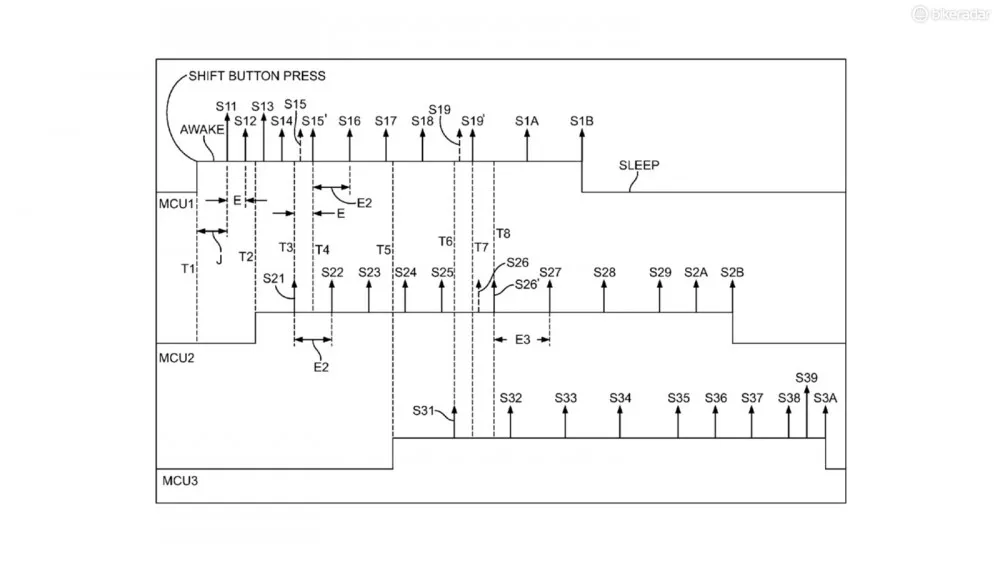
A schematic diagram for how the dwell and active times for the receivers and transmitters are parsed
Moreover, the default mode for the shifters and derailleurs is 'sleep'. A button push instantly 'wakes up' each shifter's transmitter, and that signal correspondingly activates the uniquely paired receiver.
SRAM's patent documentation doesn't outline specifics in terms of run time but it does claim a power draw that's just one-tenth of a wireless system that's always on. The automatic sleep mode means users won't have to manually shut things down, either, as is required for Campagnolo EPS.
Keep in mind that all of this goes on in the background and if all goes according to plan, users should never have to give it a second thought. The benefit of that lower power draw, however, is the ability to use comparatively minuscule batteries for the derailleurs. This reduces weight – thus preserving SRAM's long-standing bragging point of being the lightweight leader – while possibly still maintain similar run times.
By our eyes, both batteries are completely identical and interchangeable, popping out of their housing with simple flip-up latches. We expect some sort of dual-socket desktop unit that will recharge both removable batteries simultaneously, meaning your bike would never have to be shackled to AC power, either.
MTB version to come, plus other expanded functions
Still want more? The patent application mentions the possibility of an electronic mountain bike drivetrain as well as a system for internally-geared hubs. Integrated ANT+ and/or Bluetooth Low Energy wireless protocols would allow compatible computer heads to display all sorts of other data, like battery life and gear position. It's also possible that updates and component programming could be performed wirelessly.
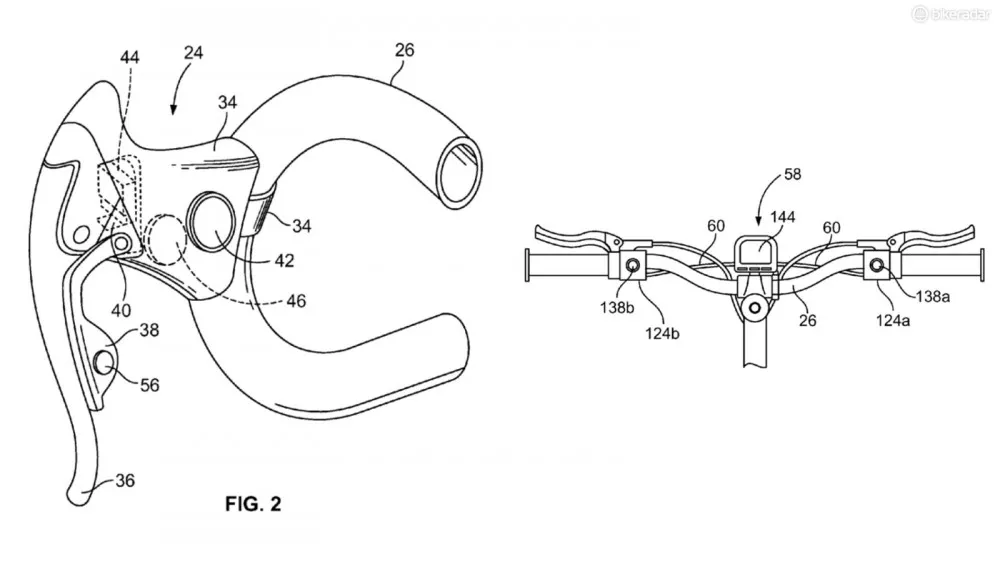
SRAM electronic MTB coming soon?
Big thanks go out to reader Lee Myers – our 'eyes on the ground' in California.
